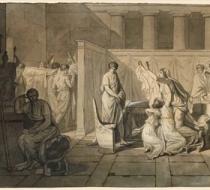The Lictors Bring to Brutus the Bodies of His Sons Favorite
Jacques-Louis David was an active member of the French Revolution, and his works often depicted his political affiliations. David’s painting The Lictors Bring to Brutus the Bodies of His Sons portrays the scene of Brutus, an important figure of the Roman Republic, reacting to the death of his sons. Since they wanted to overthrow the government and restore the monarchy, Brutus ordered their death.
This painting is a representation of civic virtue and Brutus’ immense sacrifices for the Republic. The government prohibited the exhibition of the artwork at the Salon because it could be interpreted as propaganda supporting the French Revolution. A ban on the painting was announced in the newspaper and it caused an outrage that forced the royal court to give their permission for the exhibition of the painting.
"David wanted to exhibit his picture in the Salon but before that the French Revolution had begun. The newspapers in France reported that the government had banned the showing of the famous painting The Lictors Bring to Brutus the Bodies of His Sons’, the people were outraged on the government and several royals were forced to give up. The painting was then hung in the exhibition and protected by art students." (https://www.theartist.me/artwork/the-lictors-bring-to-brutus-the-bodies-... )







